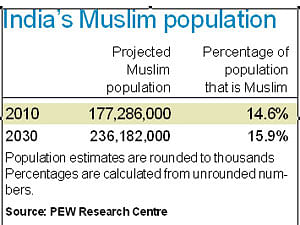India's Muslims expected to grow at slower rate: Report

The report forecasts that the number of Muslims globally will also grow at twice the rate of non-Muslims over the same period, but the rapid growth will level off.
Part of the reason for this sluggish growth, according to the report, is greater access for Muslim women in education and jobs, migration to cities and improved living standards. The birth-rate in Muslim-majority countries will come to more closely resemble the pattern in other nations.
But the PEW Research Centre says that India will continue to have the third-largest Muslim population with its share expected to increase from 14.6 per cent now to 15.9 per cent by 2030 by which time Pakistan will surpass Indonesia as the country with largest Muslim population, and Nigeria will surpass Egypt.
In the United States, the report found about 2.6 million Muslims in 2010, a number projected to rise to 6.2 million in 20 years. At that rate of growth, Muslims would still be a religious minority in 2030, 1.7 per cent of the American population, which is about the equivalent of Jews in the US.
The report could challenge assertions in the political discourse about future demographic domination by Muslims, based on assumptions that they are populating the earth at an exponential rate. India's Muslim population is expected to grow at a slower rate in the next 20 years than it did in the previous two decades.
The report emphasises that fertility rates for all populations in India have been declining in recent years, in part because of increasing use of birth control. However, Muslims in India continue to have more children on average than non-Muslims, mainly because Muslims' use of birth control still falls below the national average.
Muslims in India are poorer and less educated than other religious groups. These characteristics are often associated with higher fertility rates. Besides, the literacy rate among Muslim women (50.1 per cent) is lower than the rate among other women in India, including Hindus (53.2 per cent) and Christians (76.2 per cent).
In 2005-2006, for example, 45.7 per cent of Muslim couples used some form of birth control, compared with 56.3 per cent of couples in the general population, according to an analysis of the National Family Health Survey.
According to the 2001 census, a large concentration of Muslims lives in two of the largest and poorest states, Uttar Pradesh and Bihar; 35.6 per cent of all the Muslims in India live in these two states.
An additional 14.6 per cent of the country's Muslims live in West Bengal, which adjoins Bihar and borders Bangladesh. The remainder of the country's Muslim population is scattered in more than 20 other states.
Although Muslims constitute a small minority in most Indian states, they make up roughly a third of the population in Assam (30.9 per cent) and about a quarter of the population in both West Bengal, where some increase in the Muslim population is attributed to illegal immigration from Bangaldesh, and Kerala.
Muslims constitute a majority of the population in the northernmost state of Jammu and Kashmir, where they make up 67 per cent of the population.
Deccan Herald is on WhatsApp Channels| Join now for Breaking News & Editor's Picks